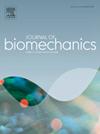Validation of markerless (Theia3D™) against marker-based (Vicon™) motion capture data of postural control movements analyzed through principal component analysis
IF 2.4
3区 医学
Q3 BIOPHYSICS
引用次数: 0
Abstract
Markerless motion capture systems, such as Theia3D, offer a promising alternative to traditional marker-based systems (e.g., Vicon) not only for dynamic motion analysis, but also potentially for postural control research. The purpose of this study is to simultaneously derive and then compare principal movements (PMs) from Theia3D and Vicon data collected from 13 volunteers during eyes-open and eyes-closed bipedal quiet stance using principal component analysis (PCA). Agreement between systems was assessed by computing correlation coefficients for corresponding PM time series and evaluating their sensitivity to visual condition changes. Theia3D and Vicon produced highly similar PM structures, with the first two PMs—representing anterior-posterior ankle-strategy and medio-lateral sway—exhibiting near-perfect correlation (r = 99.8 % and r = 99.0 %) and explaining a comparable portion of the entire postural variance (PM1: 74 % vs. 76 %; PM2: 9.4 % vs. 9.9 % for Vicon and Theia3D results, respectively). The first seven PMs, which collectively accounted for 97 % of postural variance, showed strong agreement (r = 0.814 to 0.928) despite fundamental differences in marker placement and tracking methodology. Correlation declined in higher-order PMs, suggesting they capture distinct aspects of postural movements or system-specific noise. Both systems demonstrated comparable sensitivity to postural control modulations induced by visual deprivation. Notably, Theia3D exhibited higher noise levels, particularly in higher-order PMs, indicating that pre-processing with filtering should be considered before PCA. Overall, these findings confirm that Theia3D provides highly comparable results to Vicon for postural PMs, reinforcing its potential as a valid and efficient alternative for postural control research using PCA-based approaches.
通过主成分分析,对无标记(Theia3D™)和基于标记(Vicon™)的姿势控制动作捕捉数据进行验证
无标记运动捕捉系统,如Theia3D,为传统的基于标记的系统(如Vicon)提供了一个有前途的替代方案,不仅用于动态运动分析,而且还可能用于姿势控制研究。本研究的目的是利用主成分分析(PCA),同时从13名志愿者在睁眼和闭眼两足安静站立时收集的Theia3D和Vicon数据中得出并比较主动作(pm)。通过计算相应PM时间序列的相关系数和评估其对视觉条件变化的敏感性来评估系统之间的一致性。Theia3D和Vicon产生了高度相似的PM结构,前两个PM -代表前后踝关节策略和中外侧摆动-表现出近乎完美的相关性(r = 99.8%和r = 99.0%),并解释了整个姿势差异的相当部分(PM1: 74%对76%;PM2: Vicon和thei3d结果分别为9.4%和9.9%)。尽管标记位置和跟踪方法存在根本差异,但前7个pm(总共占姿势方差的97%)显示出强烈的一致性(r = 0.814至0.928)。高阶pm的相关性下降,表明它们捕获了姿势运动或系统特定噪声的不同方面。两种系统对由视觉剥夺引起的姿势控制调节表现出相当的敏感性。值得注意的是,Theia3D显示出更高的噪声水平,特别是在高阶pm中,这表明在PCA之前应该考虑滤波预处理。总的来说,这些发现证实了Theia3D在体位pm方面提供了与Vicon高度可比性的结果,增强了其作为基于pca方法的体位控制研究的有效和高效替代方案的潜力。
本文章由计算机程序翻译,如有差异,请以英文原文为准。
求助全文
约1分钟内获得全文
求助全文
来源期刊

Journal of biomechanics
生物-工程:生物医学
CiteScore
5.10
自引率
4.20%
发文量
345
审稿时长
1 months
期刊介绍:
The Journal of Biomechanics publishes reports of original and substantial findings using the principles of mechanics to explore biological problems. Analytical, as well as experimental papers may be submitted, and the journal accepts original articles, surveys and perspective articles (usually by Editorial invitation only), book reviews and letters to the Editor. The criteria for acceptance of manuscripts include excellence, novelty, significance, clarity, conciseness and interest to the readership.
Papers published in the journal may cover a wide range of topics in biomechanics, including, but not limited to:
-Fundamental Topics - Biomechanics of the musculoskeletal, cardiovascular, and respiratory systems, mechanics of hard and soft tissues, biofluid mechanics, mechanics of prostheses and implant-tissue interfaces, mechanics of cells.
-Cardiovascular and Respiratory Biomechanics - Mechanics of blood-flow, air-flow, mechanics of the soft tissues, flow-tissue or flow-prosthesis interactions.
-Cell Biomechanics - Biomechanic analyses of cells, membranes and sub-cellular structures; the relationship of the mechanical environment to cell and tissue response.
-Dental Biomechanics - Design and analysis of dental tissues and prostheses, mechanics of chewing.
-Functional Tissue Engineering - The role of biomechanical factors in engineered tissue replacements and regenerative medicine.
-Injury Biomechanics - Mechanics of impact and trauma, dynamics of man-machine interaction.
-Molecular Biomechanics - Mechanical analyses of biomolecules.
-Orthopedic Biomechanics - Mechanics of fracture and fracture fixation, mechanics of implants and implant fixation, mechanics of bones and joints, wear of natural and artificial joints.
-Rehabilitation Biomechanics - Analyses of gait, mechanics of prosthetics and orthotics.
-Sports Biomechanics - Mechanical analyses of sports performance.
 求助内容:
求助内容: 应助结果提醒方式:
应助结果提醒方式:


